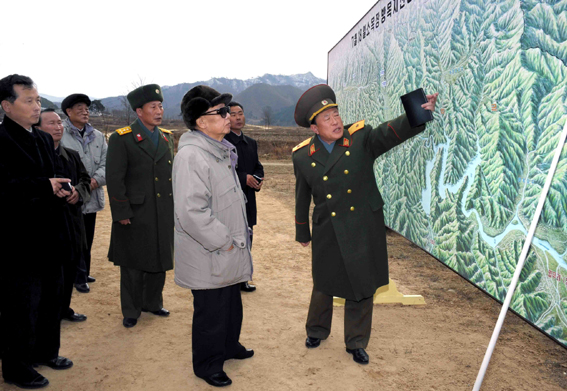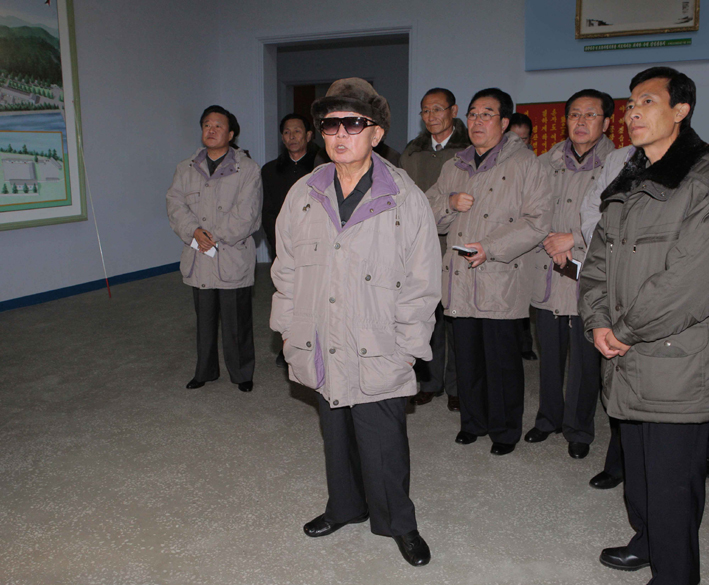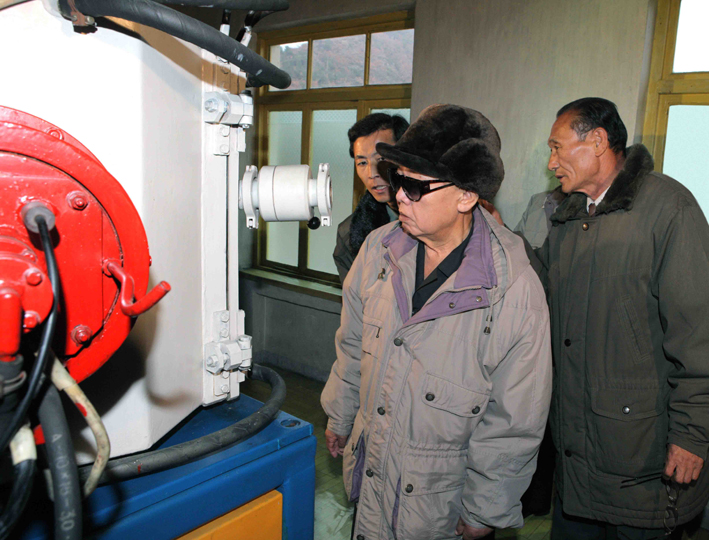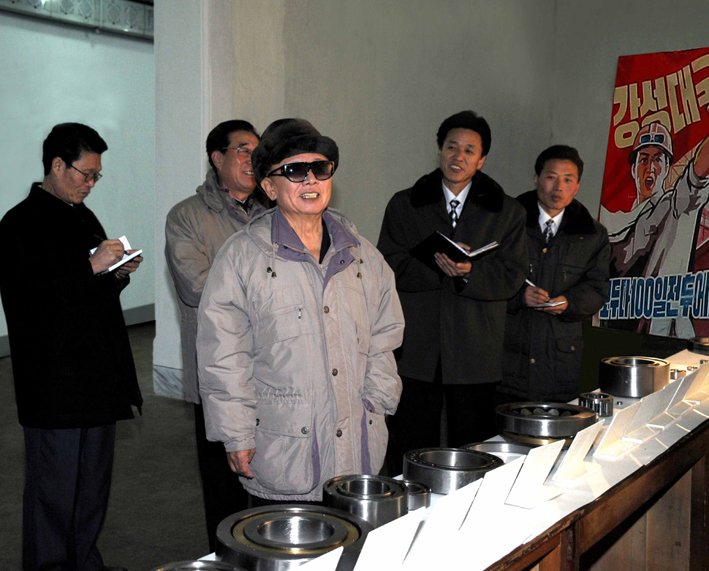The Guidance Train Over the River and Through the Woods
(n.b. Kim Jong-il’s last known appearance was around 9 November when he attended a concert given by a music troupe of the Ministry of Public Security)
Kim Jong-il laid low following the naval skirmish on the NLL and while US President Barack Obama traveled through East Asia. It seems as soon as President Obama was wheels up, General-Secretary Kim ordered the guidance train to continue its “journey of patriotic devotion. . .to bring earlier the rosy morrow.” With a recent assessment that parts of North Korea will face the worst drought in 80 years, it made sense for Kim Jong-il to do a bit of retail politicking on the food supply front.
His first appearance was to a cattle farm under the control of KPA Unit 580. Kim Jong-il walked around the cattle farm, visiting the feed and grazing areas and the stalls where the cattle are kept. As with recent KCNA reports about guidance and inspection tours, an emphasis was placed on the “indefatigable efforts” on the personnel and not to any provincial or central interventions. General-Secretary Kim was positively effusive about the cattle farm, saying, “The soldiers of the unit and employees of the farm have successively built the cattle farm by their own efforts and rapidly increased the meat production by tapping the latent reserves, prompted by their patriotic desire to give even a little help to the country.” There was also yet another concession in the report these “efforts” are difficult to come by (“under the difficult conditions where everything was in short supply”). You can watch the KCTV coverage of Kim Jong-il’s guidance tour of the cattle farm (and the whole broadcast) here.*
When everything is in short supply, domestic security is important, so Kim Jong-il ventured back to Pyongyang to the headquarters of the Ministry of Public Security. General-Secretary Kim’s inspection tour of the MPS consisted of being briefed about the “technological research” of the Ministry and touring “other places to acquaint himself in detail with the ministry’s performance of [its] duty.” Kim Jong-il remarked that “The interior force having more than a six decades-long brilliant tradition of devotedly defending the leader has reliably protected the gains of the socialist country and peace of the people by standing firm guard over the outpost of the class struggle, making great contributions to the prosperity and development of the country.” Despite giving the MPS “important tasks which could serve as guidelines” this was an inspection tour and not “field guidance.” It is highly likely this was a mission to set new policies with the inspection tour serving as a pretext for General-Secretary Kim to air his concerns about the internal security situation in the DPRK.
Kim Jong-il moved on to attend two (2) concerts over the weekend in Pyongyang. The first was an art performance of KPA Soldiers from Unit 147. There was no word as to whether “Footsteps” performed. General-Secretary Kim did not monopolize his concertgoing with the KPA and attended a performance by “itinerant art squads of the Kim Jong Thae Locomotive Factory, Taean Heavy Machine and Taean Tobacco Complex and the art circle of the Pyongyang Children’s Foodstuff Factory.” One gets the impression of a Cotton Club (Harlem or Lubbock) type early/late show arrangement with these concerts. Without referring to the 100 Day Battle Campaign, this concert certainly relates to it. At the end of the performance General-Secretary Kim remarked, “A great prosperous and powerful nation is sure to be built as such dependable working class creditably takes the lead in a drive for the building of a thriving nation.”
Kim Jong-il then embarked on a swing up through North Pyongan Province, first to Unsan County where he conducted a guidance tour of the Unsan Tool Factory. He visited the factory’s historical museum which commemorates “the wise guidance and meticulous care of President Kim Il-sung” who visited the factory several times. He then toured the factory floor saying, “It is one of the prerequisites for the development of machine industry to satisfactorily settle the problem of tools, basis of the machine-building industry.” You can watch the KCTV news that features General-Secretary Kim’s guidance tour of the Unsan Tool Factory here. *
Kim Jong-il then traveled further north to Sinuiju, the famous city that borders Dandong, China. It is likely his Pyongyang-based travel party and he stayed in the Kim Family Compound outside Sinuiju. General-Secretary Kim visited four (4) production sites in the Sinuiju area. His first inspection occurred at the Ryangchaek Bearing Factory. This was Kim Jong-il’s second known guidance tour of this North Pyongan production facility. During the tour General-Secretary Kim held the Ryangchaek Bearing Factory as an example to other work sites toiling during the 100 Day Battle Campaign noting “the enterprising work style of the workers of the factory making uninterrupted advances and innovations without a moment’s stagnation and marking time are the example to be followed by all units.”
Kim Jong-il’s second inspection occurred at the Sinuiju Shoes Factory. This was General-Secretary Kim’s second known visit to this legacy factory. His first stop was to “the room for the education in the revolutionary history,” as this was a site visited by Kim Il-sung and where General-Secretary Kim could admire the large photograph of his own inspection tour from 2000. The Sinuiju Shoes Factory exports some of its products to China. Kim Jong-il revealed himself concerned with “shoes suited to the developing trend of the time.” There were a lot of shoes put out for General-Secretary Kim’s review, particularly wellies. Perhaps this factory produced the hep pair of leather sneakers the General-Secretary has been sporting since he emerged from his stroke recovery last November. Kim Jong-il then crossed the road to the Sinuiju Grass Craft Production Cooperative, which is a spin-off of the Sinuiju Shoes Factory. The cooperative recycles agricultural by-products and produces baskets, bags and hats. During this leg, General-Secretary Kim provided his best photo-op of the year when he donned one of the cooperative’s hats which sent even a hard ass like Ri Je-gang into hysterics.
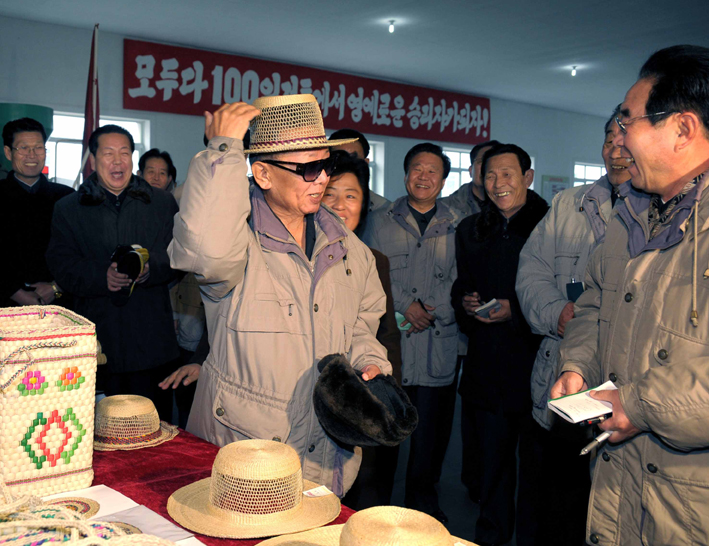
Kim Jong-il removes his fur hat for this sporty little chapeu sending his entire entourage into hysterics. (Photo: KCNA)
Kim Jong-il’s final guidance tour was to the Sinuiju Chicken Farm. This was his first known trip to what appears to be a functional food production site. Although even General-Secretary Kim acknowledges the supply problems in feeding livestock, while also alluding to the KWP’s Green Revolution: “In order to keep the production at the chicken farm going at a high rate it is necessary to pay primary attention to solving the feed problem. . .by increasing the production of organic composite fertilizer by the use of the excretion of chickens.” Kim Jong-il then left on a midnight train back to Pyongyang to meet with Chinese Defense Minister Liang Guanglie. You can see the KCTV news which includes coverage of General-Secretary Kim’s guidance tour of Sinuiju here.*
This was Kim Jong-il’s third trip to the North Pyongan area in the last month. North Pyongan seems not to be as economically dysfunctional as other parts of the DPRK, hence General-Secretary Kim’s appearances. At the end of his tour of the Sinuiju area, Kim Jong-il actually noted this, “The miraculous achievements made by North Pyongan Province recorded with creation and feats, racing against time, fully reflecting the dynamism of the country dashing ahead towards the eminence of a thriving nation.”
While the DPRK has foregone communism in favor of socialism, Kim Jong-il’s many references to “science and technology” and “scientization” have a Soviet vintage. Perhaps this is Stalinism for the IT Age. Another ideological modes advanced during this round of guidance tours was kangson taeguk. Kim Jong-il was certainly in a magnanimous and effusive mood. He is on a mission of retail politicking on these guidance tours and depicting himself as a concerned and affectionate leader. This seems intended to incite the population to slog through its hunger and exhaustion toward the 100-Day Battle Campaign. His remarks at the guidance tours and the KCNA reports contain concessions that the mid-level leadership of the KWP is failing to martial the DPRK’s meager resources, and that isolated industrial sites have had to fend for themselves.
His visit to the Ministry of Public Security was not just a run of the mill inspection. With the exception of photographs from the MPS tour appearing in Western media syndicates, the DPRK’s external propaganda has put this appearance under a media blackout in terms of photography or video images. This should serve as a reminder that the target audience of guidance and inspection tours are not an external audience.
Sure, it fleshes out the external propaganda profile, and it communicates to saner external Pyongyang watchers that General-Secretary Kim is alive and relatively well. But these appearances have a symbolism as to where and with whom Kim Jong-il appears to a broader population of North Korean elites, which is to say not only members and employees of the Central Party, but also town, city, county and Provincial KWP Secretaries and committee members, rural management committee functionaries as well as KPA officers.
So, General-Secretary Kim’s appearance at the MPS communicates to this population that Public Security remains the preeminent internal security agency in the DPRK, as against the State Security Department, with whom it regularly engages in jurisdictional turf wars. But if you’re a county Party official or rural management committee bureaucrat, you may be a bit alarmed to see Kim Jong-il turn up at the MPS headquarters. General-Secretary Kim and Jang Song-thaek (who is KJI’s proxy daily manager of internal security) were there to set a number of new policies. While many Pyongyang watchers are aware that the KPA receives a plurality of the North Korean food supply, what resources remain are lost to the corrupt activities of Party functionaries, aided and abetted by local Public Security branches. General-Secretary Kim and Mr. Jang were on a mission to crack skulls and tasking Minister of Public Security, Gen. Ju Sang-song, to directly intervene.
For all those on permanent succession watch, those DailyNK stories alleging the succession campaign was toned down, may contain a kernel of truth. There were no references to “youth” or “youth shock brigades.” There were also no references to “generations” or “posterity.” There were places in the KCNA and KCTV reports where one would normally encounter any of these themes, but they did not materialize. A strong and prosperous nation seems to be the top priority these days.
And who rode the guidance train and took in an art squad gig with General-Secretary Kim? KWP Secretary Kim Ki-nam was at all of these appearances along with KWP Financial Planning Director Pak Nam-gi and the ever-lovin’ Jang Song-thaek. KWP Secretary Choe Thae-bok escorted Kim Jong-il to the KPA concert along with Chief of the General Staff, Gen. Ri Yong-ho (there’s a bio I need to do), NDC Vice Chair and Minister of the PAF VMAR Kim Yong-chun and GPB Senior Deputy Director and NDC Member Gen. Kim Jong-gak. At the MPS, Kim Jong-il was met “on the spot” by Minister of Public Security and NDC Member Gen. Ju Sang-song and political commissar Ri Pyong-sam.
In North Pyongan province (in Unsan and Sinuiju), General-Secretary Kim was accompanied by KWP Provincial Secretary Kim Pyong-hae. At various points, Kim Jong-il was joined by his closest KPA associates (and NDC Directors) Gens. Hyon Chol-hae and Ri Myong-su. At the cattle farm, he was joined by his sister Kim Kyong-hui, although if recent reports are accurate, Ms. Kim was present at all of these events. Seen in various photographs, but not mentioned in the accounts was Senior Deputy OGD Director Ri Je-gang.
The guidance train rolls on. As of this writing, General-Secretary Kim has touched down in Anhak County for a guidance tour of a cooperative farm.
*the KCTV broadcasts are located in MS PowerPoint files; right click the image and you should find a “Play Movie” option

